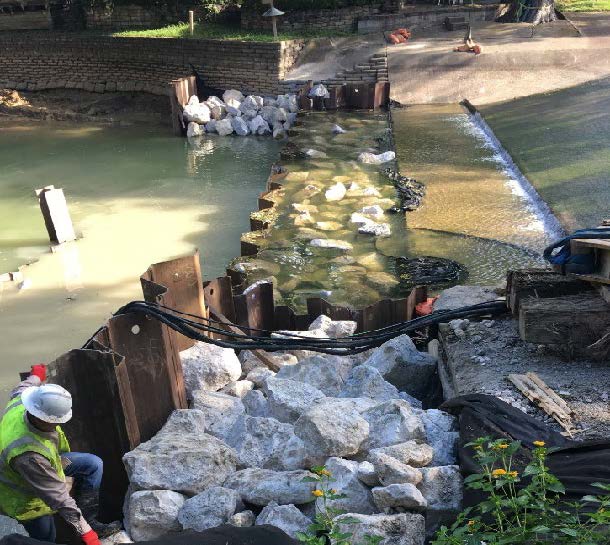Farmers Branch Creek Emergency Repairs Honored by APWA Texas
Farmers Branch residents treasure their green spaces, and homeowners along Farmers Branch Creek enjoy picturesque waterside views from the comfort of their private backyards. But torrential rains in September 2018 created a challenging emergency for creekside residents and for City leaders: Two 50-year-old private dams on the creek crumbled, and the shifting stream threatened a third dam, a private home and a public sanitary sewer line. Over the next nine months, City staff and Freese and Nichols’ multidisciplinary team of engineers and scientists staff devised a solution to stabilize the creek.
The project came together during an intense and fast-paced — and often soggy — fall-through-spring of 2018-19. The resulting repairs protected public infrastructure and private property, succeeding because of strong leadership from City staff and officials and the team’s consistent focus on cooperation in a high-pressure situation.
The underlying problem on Farmers Branch Creek was streambank erosion that rapidly grew dangerous. The initial dam failure allowed floodwaters to rush through a previously ponded area, with erosion chewing away at residents’ property and closing in on a sewer line running across the creek.
Right: A broken private dam on Farmers Branch Creek diverted the water and increased erosion, compounding a threat to residential and public property.
Elected officials, alarmed by the developments as well as by their constituents’ concerns, held multiple public meetings to weigh their options. To curtail further damage and repair the creek, City staff collaborated with Freese and Nichols to develop a swift, effective containment and rehabilitation plan.
Within days of being deployed to the site, Freese and Nichols engineers and fluvial geomorphologists came up with conceptual solutions to prevent further immediate damage. Short-term stabilization measures were put in place in fall 2018, but when heavy rains picked back up in the spring, the team and City staff knew it was time to design a permanent solution. Construction crews had to contend with a limited area of access and the unrelenting rainy season. In several instances, the dynamic site conditions on the creek required the team to make adjustments and devise alternate approaches, even as construction continued.
Ultimately, the team designed and built a grade-control structure and 500 feet of streambank stabilization improvements and implemented emergency rehabilitation measures that avoided a third dam failure. These improvements have provided much-needed flood and erosion protection to Farmers Branch Creek.
Unusual Accomplishments Under Adverse Conditions
Conditions in Farmers Branch created a perfect storm of adversity:
The City and Freese and Nichols had previously dedicated significant time and resources to identifying areas of erosion risk along the creek and developing a capital improvements plan to address these issues. However, before they were able to enact these plans, unpredictable and uncontrollable weather conditions caused unexpected, rapid deterioration of conditions along the creek. City leaders had to adapt and take quick, decisive action to curtail further damage.
The situation demanded immediate, short-term repairs to reduce risks and avoid more expensive problems down the road, but long-term solutions also had to be developed.
Close scrutiny from vocal residents and elected officials created a more intense public focus than is typical for this type of project. The team had to develop options that were sound from an engineering perspective, affordable for the City and acceptable to residents.
Construction took place during a continually rainy season — more than 20 inches of rain during March-June 2019 — with water often still running through the creek during construction.
 The ability to implement design components quickly had to be a primary consideration and played a large role in the overall final product. For instance, a sheet pile stabilization design was selected because of the speed of construction, but the contractor couldn’t procure the equipment or materials to install the desired 30’ sheet piles within the necessary time frame. To adapt, the design was augmented to require a grouted rock riprap plunge pool that also provided additional structural support to the 20’ sheet piles that were used.
The ability to implement design components quickly had to be a primary consideration and played a large role in the overall final product. For instance, a sheet pile stabilization design was selected because of the speed of construction, but the contractor couldn’t procure the equipment or materials to install the desired 30’ sheet piles within the necessary time frame. To adapt, the design was augmented to require a grouted rock riprap plunge pool that also provided additional structural support to the 20’ sheet piles that were used.
Right: A sheet pile grade-control structure provided the best solution to stabilize the dam, which was repaired with water still flowing.
Changing site conditions required the team to be nimble and creative, adapting the design as construction progressed. For example, the design team procured a field survey as the basis for design, but because the site was so unstable and erosion was progressing so rapidly, as soon as it rained, the survey was no longer valid.

